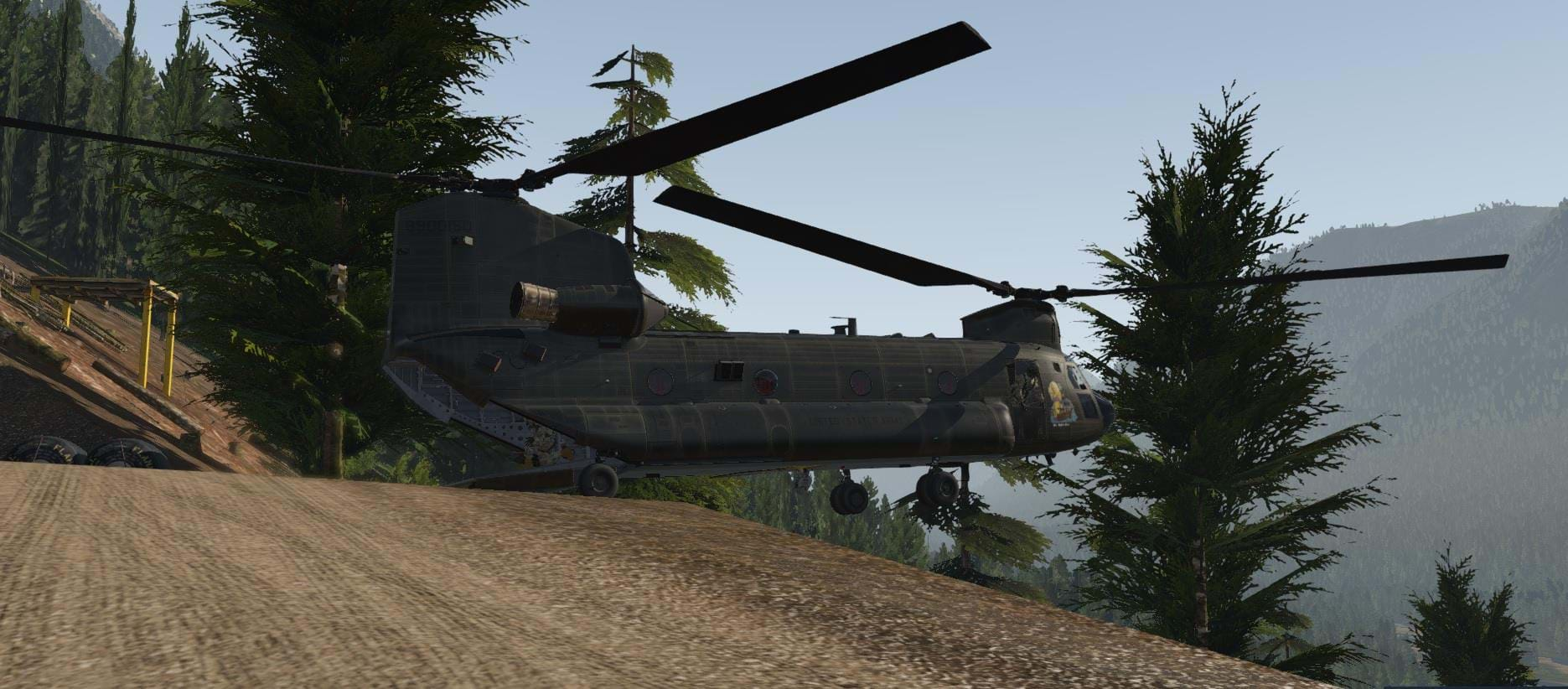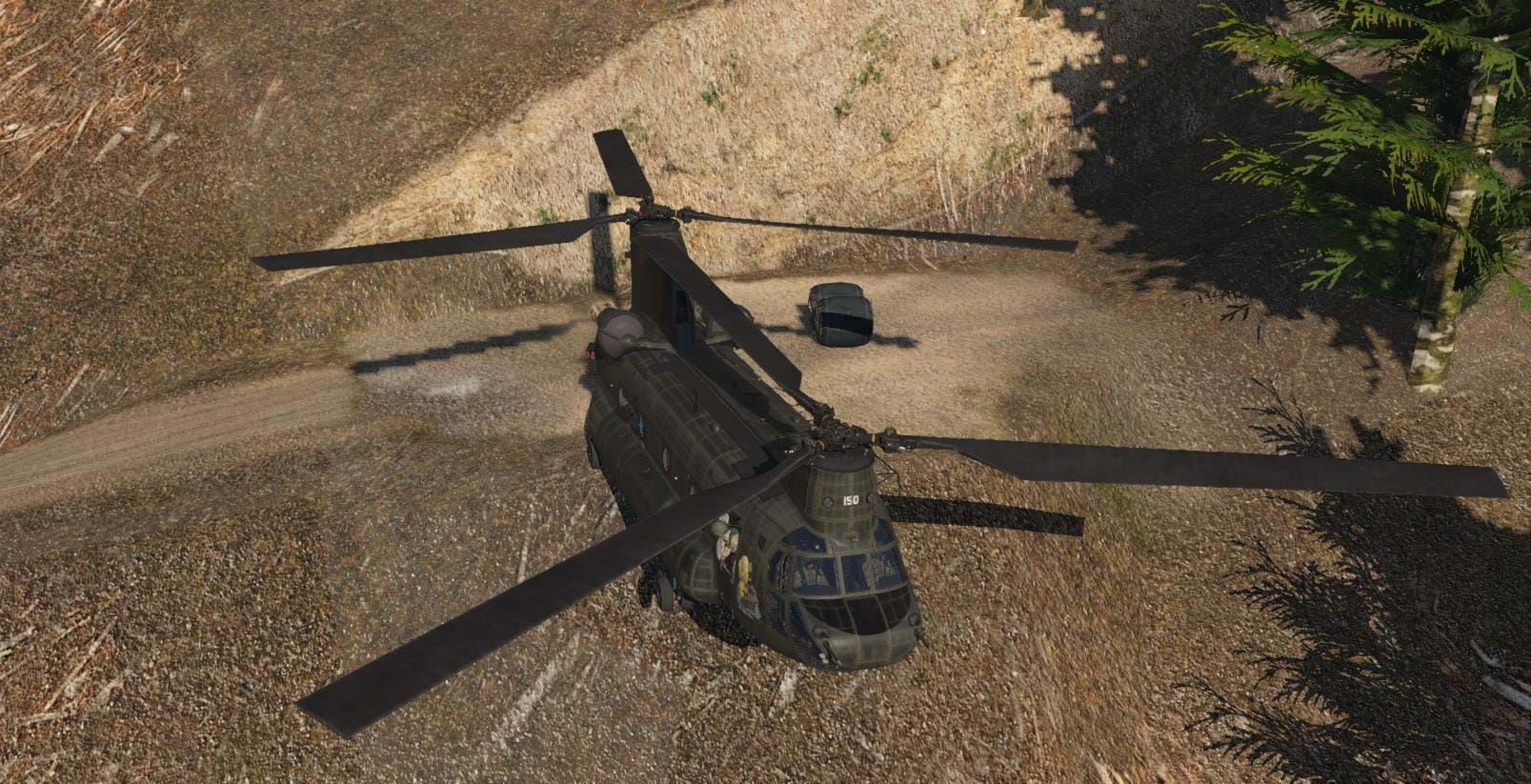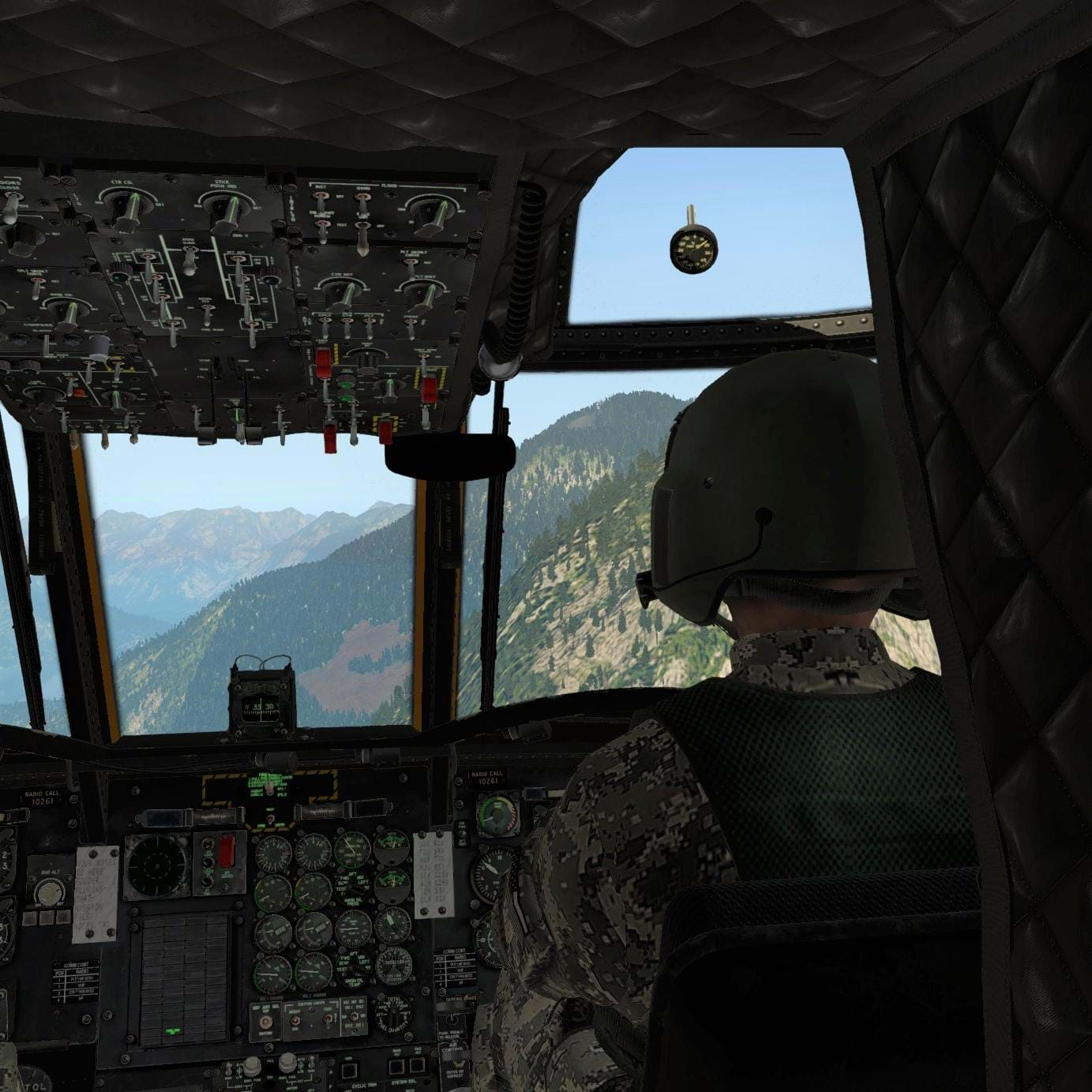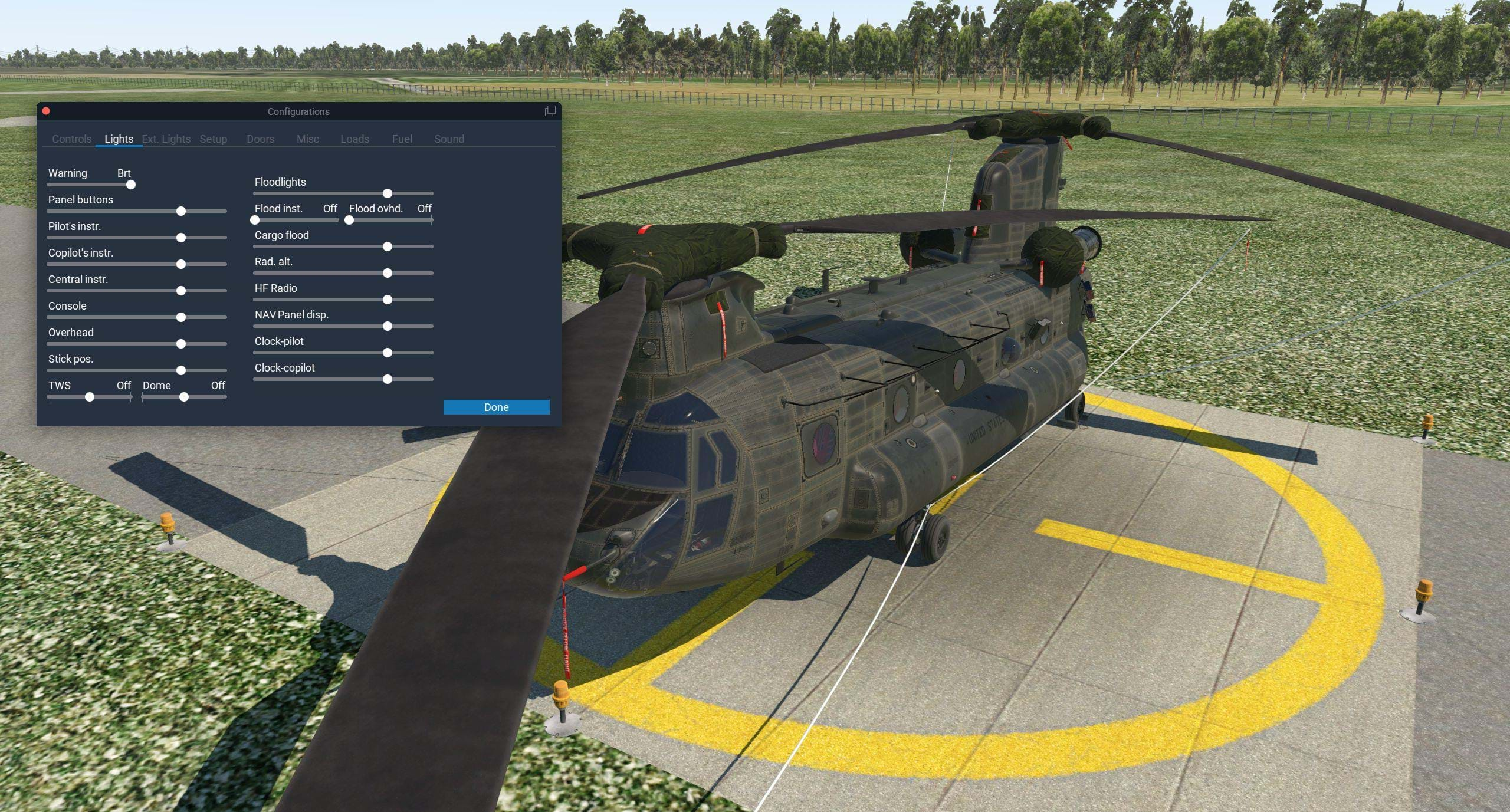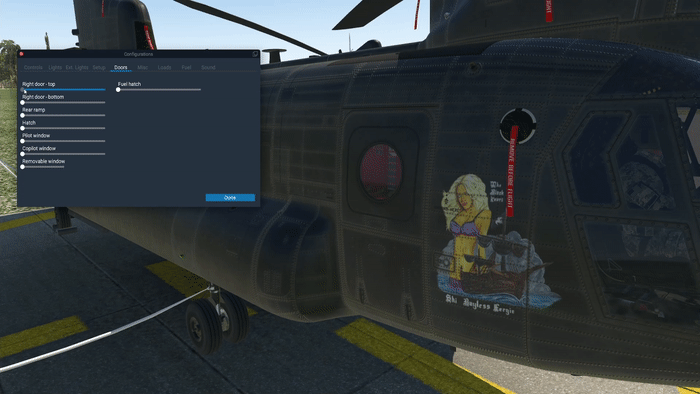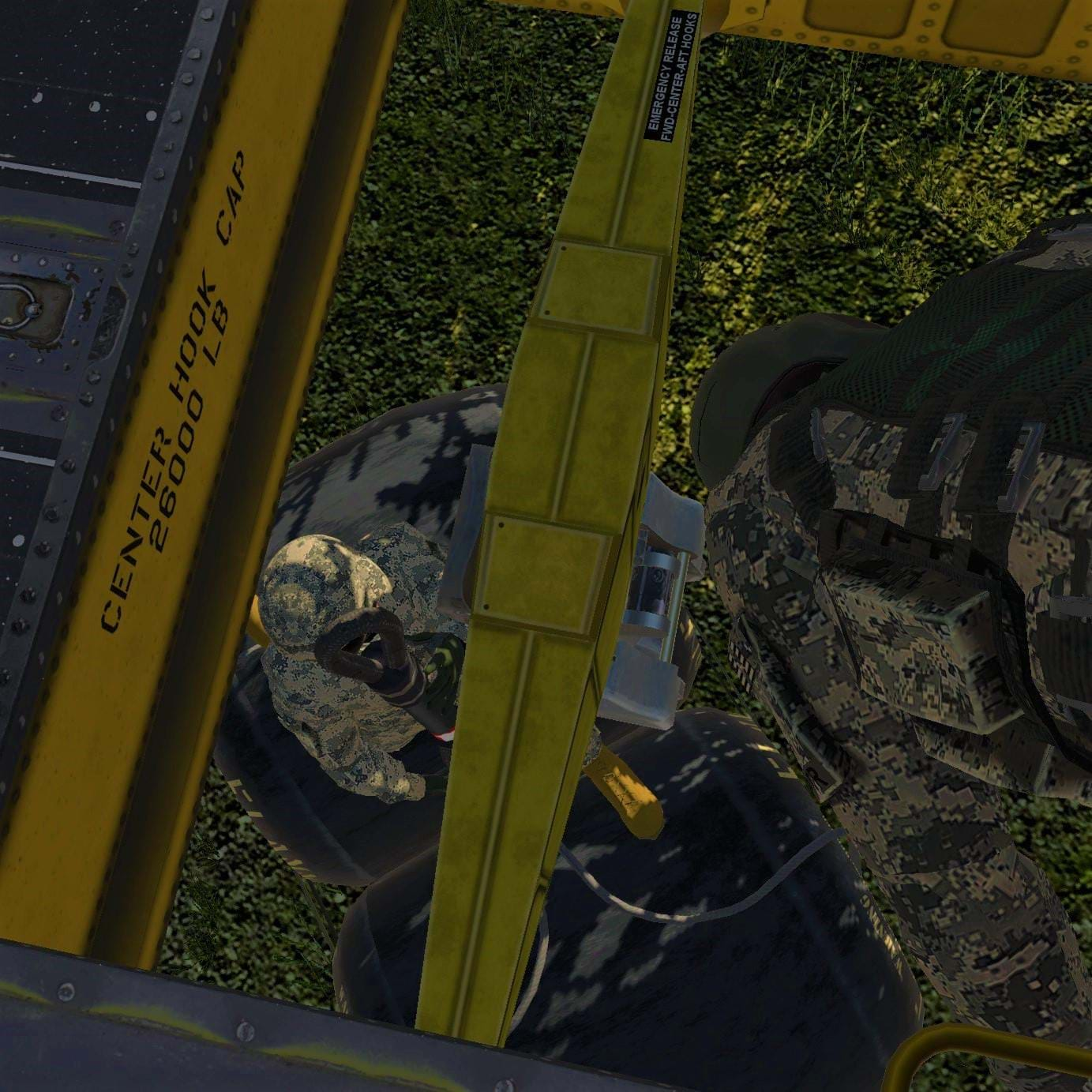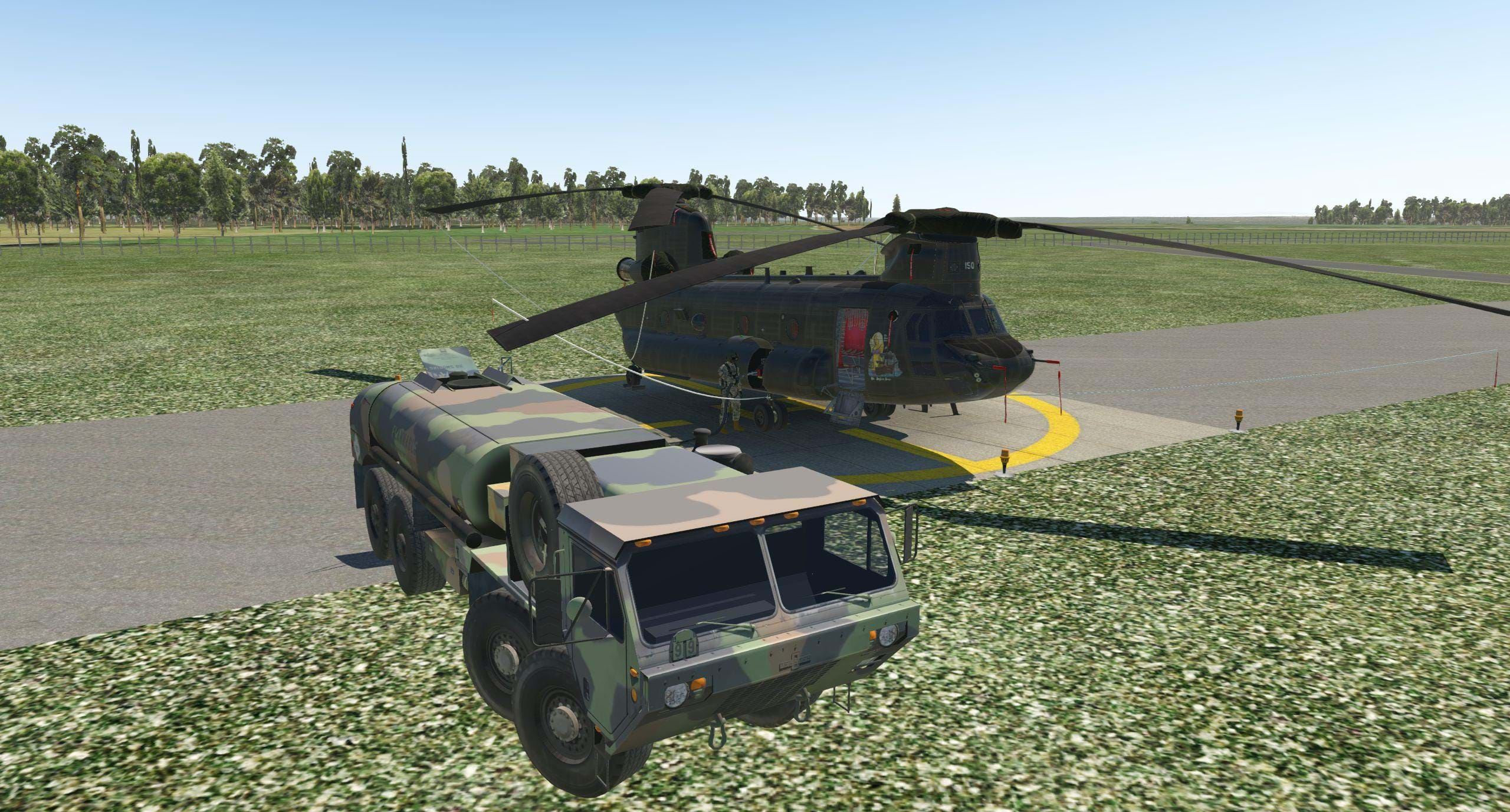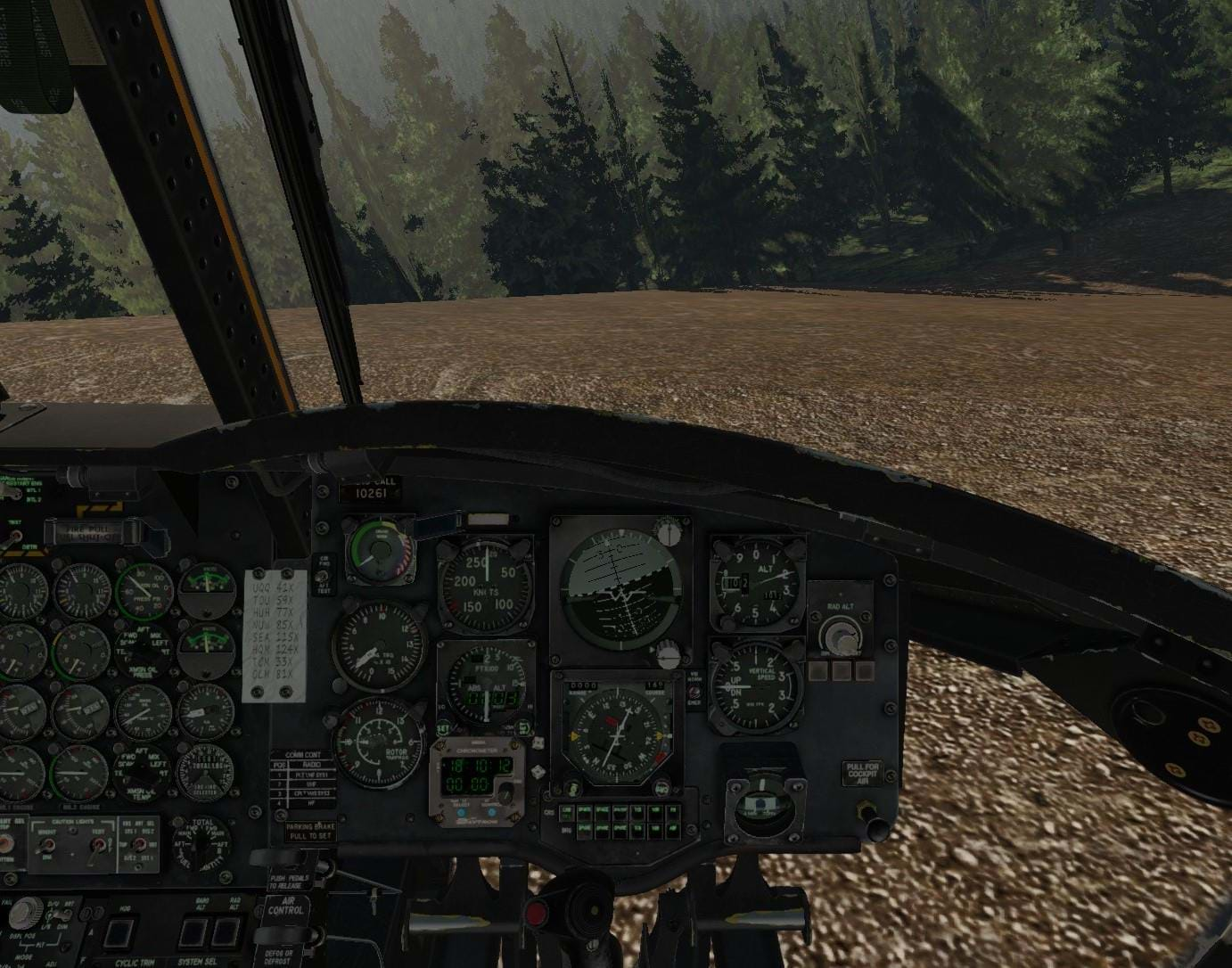Helicopters conduct a variety of different missions throughout the aviation industry and while many of them follow a set series of design considerations, there is one that is the quint-essential “semi-truck” of the helicopter world.
Called upon to lift everything from troops, trucks, guns and even other helicopters, the CH-47 Chinook stands by the phrase, “if it fits, it ships.” X-Trident has tackled a difficult and unique helicopter to integrate into X Plane 11 and one of our resident pilots has his two cents on the project.
I really struggled with how to start this review off; it was not easier since I am currently a Chinook pilot or that it has been a year since I have done any writing because of work.
But, like my previous writing projects, I figured I would just jump into it. The first thing I asked Sérgio was, “How nerdy can I get?” and he said, “Don’t be nerdy.” This was a big disappointment because, as a Chinook pilot, we’re encouraged to learn all the systems and how the marvelous 1950’s engineering enables the voodoo magic to happen – look up the Integrated Lower Control Actuators (that’s all I will say Sérgio, I promise).
Caveat: While I have been around several 47D models and crawled all around them, I have only operationally ever flown the “47F, Fox model” Chinook. Any discrepancies that I have found have been limited to 47D reference materials I was able to find and off the understanding that many of the mechanical systems and much of the procedural data was similar.
The “Fox model” differs only in those systems have been added and considerations for utilizing the digital augmentation. This is a simplification in some terms but does not detract from what I have ascertained is essential in conducting a thorough review.
Before I get too far ahead of myself, I will start off with a brief history of the CH-47 and then we’ll dive into X-Trident’s work.
Tandem rotor helicopters are not a new concept and since men have been trying to crack the helicopter problem, tandem rotor helicopters have existed in some form or another. One of the earliest successful types was the Florine Helicopter in 1926.
As far as a tandem design that would be recognizable today, we have Focke-Wulf to thank with their FW-61 which was introduced in 1936 and successfully demonstrated by Hanna Reitsch who flew the design after only a 30-minute ground briefing.
But Frank Piasecki was the pioneer who said, “This whole tandem rotor design makes a lot of sense.” He speculated (successfully), that a tandem rotor design would require less engine energy cost by removal of the anti-torque tail rotor (as much as 15%) and allow for a wider center of gravity which would enable more cargo lifting capacity.
After several successful types were used throughout various military branches and the helicopter concept had proved its worth throughout the Korean war, Vertol proposed a design that they thought the Army, Navy and Air Force should want. This resulted in the CH-46 helicopter, which was a smaller, lighter version of the CH-47.
Although after consideration, the Army reviewed Vertol’s design considerations and stipulated some specific requirements: The helicopter had to be able to carry a lot of cargo, have a rear loading ramp, amphibious capability and able to be upgraded and maintained easily.
Hence, on April 28th, 1961 the first CH-47A was rolled off the production line. First operational Chinooks saw combat in Vietnam in less than four years after the initial prototype was approved. Since, the Chinook has undergone various upgrade and improvement programs. Some small and some significant; the first Chinooks were only rated at 33,000 pounds.
The current F variants can take off with a max gross weight of 50,000 pounds and incorporate full “glass” cockpits and digital automatic flight controls which enables us to hover within a foot of a commanded position.
Enough of that stuff, I guess I should probably get to the material you are all here to read: The actual review of X-Tridents CH-47D Chinook.
Installation
Installation is a breeze and the standard procedure for any X Plane add-ons that do not have a self-installer.
Simply download the module, unzip, and place it in your XPlane11/Aircraft/Extra Aircraft folder. For Steam users, it will be located under your: Steam/Common/Xplane11/Aircraft/Extra Aircraft folder.
From there, the CH-47D will populate under your helicopter sub-folder within X Plane’s aircraft menu. The only note I will add here is that Alberto has been consistent at releasing quick updates for the project as users have reported issues and requests.
This is phenomenal in that, unlike some add-ons, after the developer releases a project, updates roll out slowly and meanwhile, end-users are stuck with frustrating issues. It is nice to see a developer that is reactive to his audience and willing to accept constructive and meaningful feedback.
I have seen a few instances of people being frustrated with the distributed manual for the module. To be objectively fair, I thought the manual was great. It provided me enough information to get the module working and understand the basic principles of how a Chinook works. I was also pleased to see limitations and flight dynamics discussed in his manual and thought that it went a step above.
I know some users have provided a “full -10 (technical manual)” for the CH-47D on the forum. If you are not pleased with X-Trident’s manual, go download that one and use it but I think it dives far deeper into the weeds than what most average users ever want to go. Additionally, a note on checklist usage: bear in mind, the official checklists are built with the expectation that there will, at the very least, THREE people going through the checklist simultaneously as a crew.
In this sense, understand that there are steps in an official checklist that you can never complete. An example of this would be doing the FADEC Back-up Power check. The official checklist states: “FADEC B/U Power switch on, wait until the ENG 1 & 2 FAIL Capsules are extinguished, ECL’s 1 & 2 – to ground, check 88’s is displayed on FADEC 1 & 2.” This step cannot be completed in the X Plane Chinook because you have no Flight Engineer to check those, and they probably are not modeled. The checklist is designed so that the left seat pilot conducts most of the checks.
Models and Textures
The model is done beautifully. As soon as I got the model loaded up in the simulator, I grabbed the VR controller and did a casually slow stroll around the aircraft and scrutinized the model.
From the various screenshots posted under the development thread on the X Plane forum, it’s obvious that he carefully researched the aircraft and utilized as much actual reference material as possible to carefully construct the model line for line, curve for curve and it shows. There are a few cockpit shapes that I found to be a bit odd; the Engine Condition Levers (ECL’s) seem too small and the lower center console size and position seem shifted too far to the left.
Additionally, the “eyebrows” which are the support pillars for the overhead skylights appears to be flipped. The exposed rivets are long the top of the eyebrow, not along the bottom. Yet, I will note something I find significant: the 3-dimensional scaling in virtual reality is spot on. I cannot over-emphasize how genuinely impressed I was to find this to be accurate.
I utilized a highly scientific method to prove this, with my VR controller. I moved my hands to various places around the cockpit, specific things that I do while flying a CH-47 every day, and it all feels correct. From manipulating the ECL’s to resetting the parking brake handle, everything feels accurate between each cockpit station.
I have found that other developers will often get small details incorrect at this stage. Either the cockpit scale will feel too large or too small, objects such as overhead lights and seat rails will appear oddly shaped or sized. Not the X-Trident model – besides the few issues I already pointed out – the scale of the virtual cockpit and interior cabin were precise and are one of the most important factors in providing an immersive experience for me.
Texturing is likewise, beautiful with amazing attention to detail provided for the interior cockpit and cabin sections. I could rattle on about all the details I found accurate or impressive, but I will limit it to a few observations: the grommets utilized to secure the sound proofing to the structure, the sound proofing itself sagging along the interior of the cabin, pencil marks along the dash glareshield and all the tiny connections in the cockpit for the internal communication system or air-warrior cooling unit.
Even the maintenance panel and auxiliary hydraulic fill port are beautifully rendered and textured. When I say all the minor details are there, they really are and Alberto, they are very much appreciated.
There is just one last issue I have not mentioned yet, and I speculate there is not much that can be done to fix it. The virtual pilot sits too high and forward in the seat. I surmise this is an issue of what can be placed “on top” of the existing 3D model but those seat cushions are old and worn out (seemingly even when they are new from the factory) and people sit further back and lower in the cockpit just by virtue of the cushions compressing.
Systems
I spent a lot of time considering how in-depth I should dive on systems. The determination between what’s necessary simulation versus what is “nice to have” will consistently vary based upon opinion.
There are so many systems on the 47D and 47F models and unlike civilian pilots, military pilots are often tasked with understanding “where that drop of hydraulic fluid is”. Beyond that, prior crew members and pilots who will inevitably fly this all have various information they are tasked with memorizing.
With that in mind, I have attempted to distill the systems into subjects I feel are important to accurately represent the aircraft. In my distillation, if there are any questions or anybody wishes to know more, they can always reach out to me and I will attempt to answer whatever questions they have but for the purpose of the review, I will keep it simple.
Command Menu
Much like the Bell 412, X-Trident provided an amazing controls menu which allows the user to select multiple different options.
These range from flight control tweaks, lights, external loads, fuel, fuel animations and doors. I always appreciate having an external menu than sometimes poking around the cockpit looking for a specific switch or dial and then attempting to utilize a VR controller (more about that later) to manipulate it. In due form, X-Tridents external menu is well designed, simple and provides appropriate options and configurations for the helicopter.
For lights, the menu is especially handy because, when loading up the simulator from a started configuration, I usually go through and set the lighting to the conditions I would normally expect; It is fast and intuitive. For doors, this means, I pop both pilots’ windows open, set the crew and lower the ramp to halfway and open the top right cabin door.
This is a common configuration we typically use in nice weather. And for those long flights when the AFCS is doing its job, it is nice to lower the ramp to level and sit back there to enjoy the view.
The external loads menu is essential to use the external load options provided with this helicopter – which is amazing. My only gripe here is a small one. I noticed that the latch zones for the associated loads were a little wonky depending on position of the load.
We always say that the Chinook is a crew-served weapon and external loads really illustrate that point nicely. I do in fact, have a crew member who has half of his body dangling out of the bottom of the helicopter looking for the external load and calling me on top of it. He also has a six-foot-long shepherds’ pole and will lean down grab the clevis and hook it up to the hook.
In this sense, I found the default load hook-up to require a frustrating amount of precision and the easy hook-up mode way to simplified. It’s also nearly an impossible task from the cockpit and for the die-hard enthusiasts that refuses to leave the cockpit to do loads, then you are doing it too hard. An external view is required and what would be a nice feature to have would be a top-down view to be able to see the center hook while flying the aircraft from the cockpit.
Automatic Flight Control System (AFCS)
This is a section that both surprised me and disappointed me (albeit there was little disappointment).
My first concerns when I heard a Chinook was being developed was that it was going to be a disaster or a bastardization at best because of the unique considerations of the AFCS and how it interacts with a tandem rotor system.
I was pleasantly surprised to find that it was neither of these. What I discovered is that Alberto had blended the best of the AFCS systems with the accuracy necessary to faithfully reproduce the key aspects of how the Chinook flies. The simulation is not perfect but its good enough that I was practicing roll-on landings with it in anticipation of practicing them in the real aircraft the following night.
If that is a sufficient statement for you, then skip to the next paragraph because here I will get a bit nerdy, but I think is important for the faithful customer to understand truly what a beast and mechanical marvel this system is. “The flight control system is electro-hydraulically operated and powered by two, independent and irreversible hydraulic boost systems and four, upper boost actuators and a linkage system that mixes and transmits control motions from the cockpit controls to the rotor swashplates.” Simply put, flight controls go to hydraulics, those receive an electrical input (from AFCS) and then that is hydraulically transmitted via mechanical controls to the rotors. The AFCS system uses inputs from the flight control computers to make an electronically driven correction to the hydraulics to fly the helicopter. Simple right? In this essence, the AFCS provides a lot of assistance to the pilots flying the helicopter. The “native modes” (modes that are on continuously in the background) that X-Trident has built into the X Plane 11 CH-47D work, and they work very efficiently. I was surprised to even see that the Longitudinal Cyclic Trim actuators (LCT) worked correctly.
The only disappointment I discovered with the AFCS systems was that the Centering Device Release (CDR) button on the cyclic did not work correctly. The actual Chinook flight controls have magnetic brakes and springs to provide an appropriate “feel” to the pilot controls.
When the CDR is depressed, native modes are paused, the magnetic brakes are interrupted and the cyclic can be re-positioned freely to the desired position. Upon release of the CDR, the magnetic brakes are re-engaged, and the springs are held in the selected position that the pilot has commanded via the cyclic.
In simplistic terms, press the button, move the stick, release the button and the stick remains in the position it was left in. Each Chinook pilot has their own method they use for CDR presses and often, it is a learning curve for new pilots (coming from a conventional helicopter) to understand when and how to appropriately utilize the CDR.
Most pilots prefer a “snapshot” method of using the CDR where, we make a control input, tap the CDR, and then might follow on with other presses to “fine-tune” the position. If we are making minor control adjustments to slide around in a hover, we will often not bother pushing the CDR at all and just push through the spring forces.
The CDR affects both pedals and cyclic controls on the helicopter. In this sense, I can intentionally put the aircraft out of trim, tap the CDR and the selected pedal position will be retained. On the X-Trident CH-47, pressing the CDR only interrupts the AFCS native modes to enable controls displacement but then the cyclic returns to the neutral position. I tried this both with a spring-centered joystick and a non-centering joystick. The spring-centered joystick provides a more realistic cyclic feel but again, the CDR does not work correctly and with the non-centering joystick, I found that the CDR did not really have a use whatsoever.
To sum up, the AFCS and flight controls, despite the minor CDR issue, I was incredibly happy with how the Chinook handled and the level of simulation built into the system. No, its not perfect but I think that it provides a 90% simulation of how the Chinook handles.
Cruise Guide Indicator
The Cruise guide indicator (CGI) is the neat looking gauge located in the upper left portion of the panel.
It contains a series of colored bands that range from green, to yellow and red with a small white index marker on the top portion of the gauge.
The CGI gives the pilot a visual indication of actual loads imposed upon critical components of the helicopter. We say that our limited airspeed (up to Vne) is determined by the CGI. A good way to think of the gauge is as a visual representation of the complex charts located in the back of the technical manual.
I found in the X-Trident CH-47 the CGI did not work correctly. Although I could test it successfully, when I was flying in different configurations of airspeeds, altitudes, and gross weights I did not notice a perceivable change on the gauge. I am not sure if the CGI implementation is an X-Plane limitation or if Alberto was not sure how to implement use of the gauge.
A potential way to code it is by a variable graph. The heavier the helicopter sensed load and higher the airspeed, then the higher that gauge should peg near the top of the green band. Then, as maneuvers are conducted at those speeds, that band would peg to yellow and red.
Other systems
I found other systems of the helicopter to work as expected. I conducted my standard tests where I would put the helicopter into various configurations and then fail an engine. I would then attempt hovering and other flight maneuvers to ensure torques reflected accurately and utilize the published checklists to re-start the failed engine.
I would also go through and test the fuel pumps by shutting those down appropriately and monitoring for accurate fuel flow and tank feed characteristics. I did not find any glaring faults or major issues that I thought would be significant to the average user.
Virtual Reality Integration
By far, the most infuriating issue I have encountered with X-Tridents Chinook is VR manipulation of controls within the cockpit.
It is my biggest complaint with the entire helicopter. When utilizing VR controllers to manipulate switches and dials in the cockpit, the manipulators are finicky (am I controlling the front of the switch or the back?) and when setting the Course Deviation Indicator (CDI), Heading or barometric pressure, the dial resets to a default position.
With the CDI/HDG bugs, it resets too “north”. With the barometric pressure, I think it resets to 29.92. This function is very annoying. Although, the X-Trident Chinook is not the only helicopter where VR manipulation can be a painful process, so I attempted to rely on my old backup, pop up the mouse cursor and manipulate those dials using that – the mouse cursor did not work either. The mouse cursor does with switches although, it does not work dials.
Fuel Truck
Another neat feature of the X-Trident Chinook is the custom HEMETT Fuel truck! Unlike in real life, the fuel truck actually gets there when you call upon it (in the animations menu). The various neat features including self-positioning or "pilot" (driver) positioning was pretty fun to play with.
But what I really appreciated about the fuel truck animation and the rate at which the aircraft refuels when it's actually hooked up to the fuel truck. It seems to take quite a while to refuel the Chinook on the ground and that's about how long it actually requires. Depending on the hose pressure from the fuel truck, sometimes we'll bring the engines down to the "ground" position to ensure we can get an adequate fuel flow.
Either way, it was a neat and appreciated detail.
Sounds
The sounds of the X-Trident Chinook are amazing.
The blade thump, slap, and auxiliary power unit (APU), all sound fantastic. I appreciated how I could also fine tune and save specific sound profiles through the command menu. The oddest sensation was starting a descent in the Chinook and hearing the rotor sounds dwindle down to nothing.
I thought something was wrong. I will say that, when flying an actual Chinook, you always hear some sort of feedback from the rotors or, as a pilot up in the front, the forward transmission which is located immediately aft and above, your head.
Flight Dynamics
I thought this section would be the most difficult to write but, how does one simulate how a helicopter flies let alone, a tandem rotor one?
In essence, just do what X-Trident did. The Chinook flies like a Chinook. Its not perfect. I feel like there is too much lag in the controls and not enough fine tune input in a hover. However, without a thorough explanation of what the sliders under the command menu affect, I am too hesitant to mess with those.
I’m sure that could easily correct the issues I have pointed out however, I have also tested a lot of helicopters and when one starts messing with sliders, it quickly becomes easy to start fooling yourself into changing sliders and trying “fine-tune” miniscule controls and then just deviating so far from the baseline that the whole helicopter flies wonky.
Beyond just changing the default AFCS inputs to “low” and adjusting the control sliders to “.09”, I did not do any other changes and tried to fly the helicopter how the average user would; the results were very pleasing. The helicopter handles awfully close to how the actual Chinook handles.
Of a concern, I noticed that in certain flight conditions, the aircraft nose tended to over-react in the longitudinal axis, that it was prone to pitching up abruptly when operating at 50 knots or slower. I believe this is a result of the LCT programming and whatever code Alberto utilized is kicking in at that point.
When the LCT’s program in the real helicopter, its tough to discern the transition point and often, the AFCS dampens much of the effects so that the pilot is not trying to “fight through” any aerodynamic forces. Although, I was really pleased to see a correct correlation of cyclic and pedal inputs to get the aircraft to turn about a specific axis. Pedal input alone turns around the center hook, cyclic and pedal displaced in opposite directions turn around the nose (based upon direction of pedal input) and cyclic and pedals displaced in the same direction, result in a turn around the tail. It is a lot of fun if you haven’t discovered that!
Performance
I am running an Nvidia 1080 GTX with 16GB of RAM and an Intel i7 Chip.
I utilize an HTC Vive through Steam VR and my headset resolution up to 150% for X Plane. Even in custom scenery regions (Quantum River, ORBX Oregon HD and a few other regions), I consistently saw 26+ FPS and no stuttering or breaks in performance that would prohibit full enjoyment of this module.
Despite the smooth performance, the modeling in the cockpit and on the exterior were phenomenal and if there were corners cut to improve performance, I could not locate any. I appreciated how detailed the cabin interior was despite not being excessively detailed. I felt it provided enough to maintain immersion without affecting performance.
Summary
If you have ever had a desire to fly a Chinook, have flown a Chinook or been a crew member on one and want one to fly with X Plane, I would strongly recommend the X-Trident CH-47D. The systems and flight dynamics are fantastic are accurate enough to provide a fun experience without being too cumbersome.
Additionally, the implementation of the load’s menu is a blast and its always fun to fly a giant Rubik’s cube around. Despite some of the minor faults, Alberto is quick to respond to his community and provide good feedback to his customers.
As a side note: If anybody would like to ask more in-depth questions about the Chinook and or, would like some coaching on basic principles for operating the X-Trident CH-47D, feel free to reach out to me. Topics of discussion will be limited to operating the simulated helicopter and components contained within the X-Trident module.

